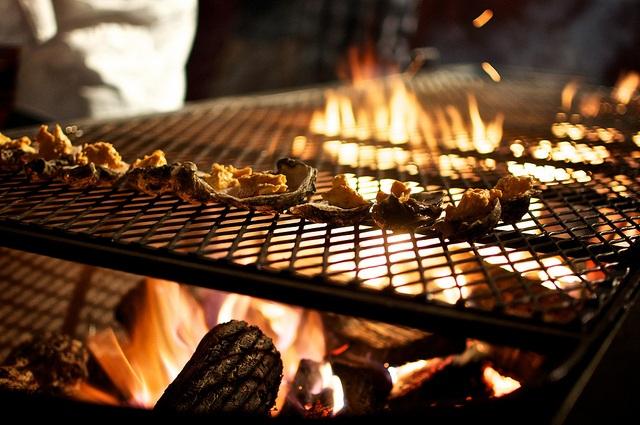
Fresno is known for being in the middle of California and being part of the vast San Joaquin Valley. Fresno, and the valley, are also known for their poor air quality: The valley has one of the most polluted air basins in the country.
Cleaning up that air is a daunting task. The agency charged with clearing the valley of pollution, the San Joaquin Valley Air Pollution Control District, is now looking at charbroiler barbecue restaurants. The reason is simple: Charbroiler barbecues cause pollution. A 2012 study found that they emit twice as much pollution as diesel trucks.
Charbroiler restaurants cause emissions that are known as particle pollution or PM-2.5. The Fresno Bee reports that regulating these restaurants in the San Joaquin Valley would only reduce emissions by “less than half of 1 ton” a day, according to the Bee. Those restaurants are responsible “for a small fraction” of the area’s PM-2.5 emissions.
Chain restaurants that use under-fired charbroilers are already regulated. The Fresno Bee reports that the air district is “looking for restaurants to participate in a pilot program to test the new technologies, with most or all costs covered.” Only one restaurant has agreed, the Habit Burger Grill in Stockton, but the air district told the Bee it is talking to two or three other restaurants and by 2017 will decide if it will regulate the restaurants
The San Joaquin Valley is the state’s top agricultural producing region. Some consider it to be the agriculture center of the world. The valley supplies half of the nation’s fruits and vegetables. But the topography of the valley allows it to become overly polluted: Surrounded by the Coast Range Mountains on one side and the Sierra Nevada Mountains on the other, the region is a bowl where pollution can become trapped.
The American Lung Association’s State of the Air report ranks the most polluted cities in the country. Fresno/Madera ranks as the most polluted city for both year-round particle pollution and short-term particle pollution. In the year-round particle pollution category, the next three cities on the list are all in the valley. In the short-term particle pollution category, the next three cities are also in the valley. In the ozone category, the No. 2 through No. 4 spots are all valley cities.
Although only 10 percent of California’s population lives in the valley, Highway 99 runs through it and serves as a major corridor for the rest of the state. The American Lung Association cites emissions from the transportation sector as a leading source of pollution. Specifically, on-road vehicles, particularly diesel trucks and buses, are cited as contributing the majority of nitrous oxide emissions (a key ingredient of ozone).
Some of the valley’s pollution comes from outside of the area. Air pollution transported from the Bay Area and the Sacramento area accounts for about 27 percent of the total emissions in the northern part of the Valley (San Joaquin, Stanislaus and Merced counties), according to the Valley Air District. In the central region of the valley (Fresno, Madera and Kings counties), 11 percent of the pollution comes from outside the area. In the southern part of the valley (Tulare and Kern counties), transported air pollution accounts for 7 percent of the total pollution.
The valley’s air quality has been actually improving. Since the American Lung Association’s first report in 2000, unhealthy ozone days have decreased by 41 percent. Unhealthy particle days have decreased by 36 percent since the 2004 report. Concentrations of particle pollution in the annual particle category have decreased by 22 percent since the 2004 report.
Given that most of the valley’s pollution is caused by the transportation sector, why is the air district considering regulations for charbroiler barbecue restaurants? The air district is required by the federal government to reduce the valley’s pollution emissions by 283 tons, or more than 80 percent, by 2024. It’s a goal that the valley likely cannot meet given what Seyed Sadredin, executive director and air pollution control officer for the air district, calls the “structural deficiencies” of the Clean Air Act.
What are those structural deficiencies? According to Sadredin, who testified before Congress in October, as the Act is currently written, it “does not provide for consideration of technological achievability and economic feasibility in establishing deadlines for attaining the associated federal mandates.” The valley has reduced pollution by more than 80 percent over recent decades, Sadredin testified, but is faced with a situation where it likely cannot meet the federal government’s standard.
The new standard is 70 parts per billion (ppb) of background ozone concentration -- a standard that Sadredin said “leaves little or no room for man-made local emissions.” The valley regularly exceeds those levels. To meet the new standard would require a “virtual ban on fossil-fuel combustion or emissions,” Sadredin said.
The air district is calling on the federal government to amend the Clean Air Act and created the 2015 Clean Air Act Modernization Proposal to suggest ways it can be modernized. Until the act is modernized and a new standard is amended, the valley is left with a situation where failure is eminent. The fact that the air district is considering regulating charbroiler barbecue restaurants shows just how desperate it is to meet federal regulations.
Image credit: Flickr/John Tornow

Gina-Marie is a freelance writer and journalist armed with a degree in journalism, and a passion for social justice, including the environment and sustainability. She writes for various websites, and has made the 75+ Environmentalists to Follow list by Mashable.com.














